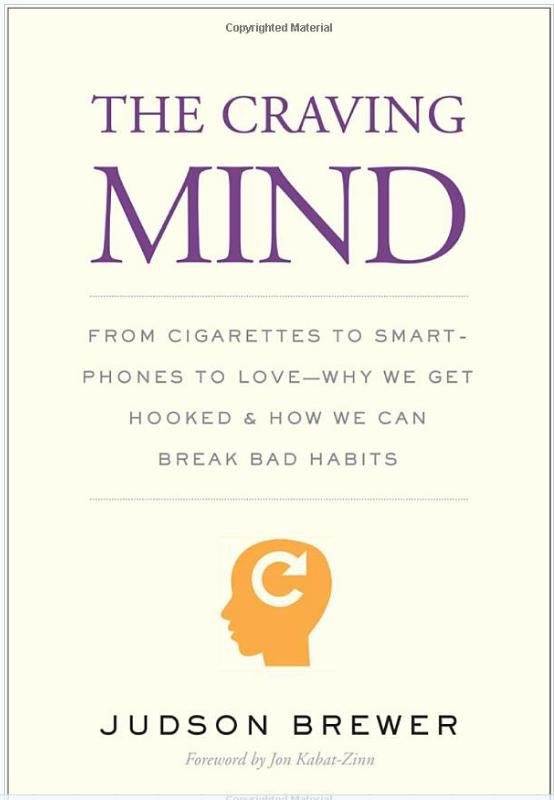 Book Review:
Book Review:
I’ll admit it right at the start: There were times when I didn’t want to like this book. As I was reading it, I composed a snide and angry review in my mind. Some of that is below. But there’s something in there which makes the book great. It’s just hidden away in lots of other stuff.
So the things that annoyed me…
First, the foreword by Jon Kabat-Zinn: He is a great man. The great man of mindfulness meditation in the West. When he writes something new, people buy books and read them. But there is really very little that is new or exciting in this foreword other than an endorsement of the book’s author. At first I thought this was purely “clickbait,” a phenomenon Brewer helpfully describes later in the book as headlines or bits of text designed to “get us fired up, and our dopamine neurons firing, so that we will click the link to read the article.”
But on a second reading, I think I worked out what the point of Kabat-Zinn’s foreword is. It’s a bit complicated. Bear with me:
My theory is that the history of mindfulness meditation in the West has various waves. The first wave was the Tibetan Tulkus, Indian Yogis, Japanese Zen masters and other weird and wonderful creatures that literally went from the East to the United States to teach their philosophies and practices. The second were people like Kabat-Zinn who soaked up all those teachings, cleared out any religious content and made mindfulness clinical, not least so that they could get medical research grants to study and teach mindfulness. The third wave consists of people like Judson Brewer who make apps out of mindfulness. (They do literally make smartphone apps, but metaphorically they also package mindfulness as an application that can make you more effective professionally, healthier, free from your addictions, and so on.) Now, there is a slight embarrassment in selling (literally and metaphorically) mindfulness as an app: How do you square the attitude of non-doing, non-striving, non-purposive awareness of the present moment that constitutes mindfulness, with the idea of “doing this in order to get that”?
It appears that Kabat-Zinn is here not to explain this conundrum but to say he’s ok with it:
“Mindfulness as both a formal meditation practice and as a way of living has two interacting aspects, an instrumental dimension and a non-instrumental dimension. (…)
The non-instrumental dimension, a true complement to the instrumental dimension of mindfulness practice and absolutely essential to its cultivation and to freeing ourselves from craving-associated mind states, thoughts, and emotions, is that there is, at the very same time—and this is very hard to take in or talk about, which is why the phenomenon of flow plays such a large role in this book—no place to go, nothing to do, no special state to attain, and, ultimately, no one (in the conventional sense of a “you” or a “me”) to attain it.
Both of these dimensions of mindfulness are simultaneously true. Yes, you do need to practice, but if you try too hard or strive for some desired end point and its attendant reward, then you are simply shifting the craving to a new object or a new goal or a new attachment and a new or merely upgraded or revised “story of me.” Inside this tension between the instrumental and the non-instrumental lies the true extinguishing of craving, and of the “mis-taken” perceptions of yourself that the craving habit is grounded in.”
I’m not sure this is entirely successful as an explanation. The tension isn’t some kind of Zen riddle or paradox. It’s not the sound of one hand clapping. It stems from a further evolution of thinking about mindfulness that needs to be made explicit, brought out into the open and argued for. Otherwise it will remain a hard sell, even if Kabat-Zinn provides his blessing for the project.
The second thing that annoyed me about the book is Brewer’s attempt to adhere to all the hallmarks of a certain genre: The kind of popular science book – or “smart thinking” as some bookshops have come to call it – that is ubiquitous and has become so lame that it’s crying out for renewal. One of the most obvious genre markers is that, before a new discovery or concept is explained, the people working on the subject are introduced at length. Not necessarily just their academic career, or their intellectual journey, but how they dress in the morning before they go to their labs, what they eat for breakfast, their individual quirks and characteristics, as well as how happy they are to be friends of the author’s. Tempting as it must be to copy ingredients of a recipe that sells so well I think this book and many others could do with less of that.
One egregious example of that feature is when Brewer talks about how the brain’s (the mind’s?) tendency to imagine various possible scenarios or outcomes. He imprecisely compares this process to Monte Carlo simulations, a statistical method to arrive at the relative likelihood of certain outcomes by running simulations thousands of times. Not only is the link between what the mind does and Monte Carlo simulations tenuous, but it is introduced with this entirely unnecessary backstory:
“I first came across Prasanta Pal in the neuroimaging analysis computer cluster at Yale. A compact and soft-spoken gentleman with a ready smile, he had just received his PhD in applied physics. When we met, he was using fMRI to measure turbulence in blood flow through the heart’s chambers. He had seen a paper of mine on brain activity during meditation, and over a cup of tea, he told me how he had grown up with meditation as part of his culture in India. Prasanta was excited to see that it was being researched seriously. In fact, he was interested in joining my lab and putting his particular skills to use.”
A third thing that was slightly irritating is that Brewer tries maybe too hard to show that his thinking about neurological and behaviouristic models of craving and addiction are not only presaged, but precisely present in the teachings of the Buddha himself. (“According to the Pali Canon, the Buddha was said to have been contemplating this idea on the night that he became enlightened. Maybe it was worth looking into further.”) At one point Brewer asks “Could [what the Pali canon refers to as] birth be what we now call memory?” Unlikely, right?
Ultimately though I found the book fascinating. It does a number of things really well:
- It describes how addictions can come about based on very basic brain functions that allow animals to survive, e. g. by remembering where they can find food. Performing certain actions give us a short-term reward (mediated by dopamine in the brain) which makes us happy, but can also give us a craving for more.
- It properly analyses certain kinds of social media and smartphone use as addictions. It describes the research that shows how people are getting addicted to presenting a certain image of themselves (their selfies) and being “liked” on social media. One fascinating study which Brewer describes links an increase in children’s accidents to parents being distracted by their phones.
- It argues that other activities fit an addictive pattern, such as (obsessively) being in love, daydreaming or thinking. This is particularly so when they are really about the person in love, the daydreamer or the thinker themselves, rather than directed at someone or something else.
- It also provides evidence that daydreaming, being lost in fantasies of pleasant scenarios actually makes us unhappy, rather than happy. (“A human mind is a wandering mind, and a wandering mind is an unhappy mind,” as the researchers of this phenomenon are quoted.)
- It then describes the research by Brewer and others that implicates a certain pattern of activity in a specific area of the brain (the Default Mode Network) in addiction-style thinking about ourselves.
- And of course the killer is that Brewer can then show that when we practice mindfulness meditation, this pattern of brain activity is absent. In other words meditation is the absence of an addictive activity to do with shoring up the self.
- So every time we give in to a craving, we become more addicted. Every time we interject some mindfulness between craving and our next decision, we become less addicted. Giving in to addiction makes us unhappier, being mindful happier.
In Brewer’s words:
“In any type of addictive behavior, reactivity builds its strength through repetition—resistance training. Each time we look for our ‘likes’ on Facebook, we lift the barbell of ‘I am.’ Each time we smoke a cigarette in reaction to a trigger, we do a push-up of ‘I smoke.’ Each time we excitedly run off to a colleague to tell her about our latest and greatest idea, we do a sit-up of ‘I’m smart.’ That is a lot of work.”
And with this, Brewer has done something that is actually even more amazing than he explicitly says in his book. He has brought some issues that were far more present in the teachings of the first wave of meditation masters than they were for the later ones back to life. Those issues concern the role of the ego and the idea that less of it might be good for us. Through his scientific research, Brewer shows that shoring up the self is an activity that makes us unhappy and is linked to addictive behaviours. He also shows that meditation helps with that, not by a process of killing off or diminishing the ego, but simply by stopping the activity in the brain associated with self-referential thinking and doing something else for a while.
Photo credit: © Dmitrii Fadeev | Dreamstime.com - Sikh in a obliteration prayer




